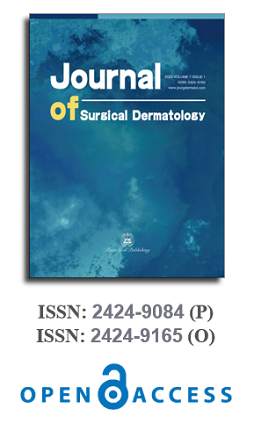Characterization of the elderly with a possible diagnosis of skin cancer
by José Antonio Bordelois Abdo, Mauricio López Mateus, Iliana Fernández Ramírez
Journal of Surgical Dermatology, Vol.9, No.1, 2024;
553 Views
Introduction:In Cuba, the study of skin cancer in the elderly is one of the social demands. Objective: To describe the clinical epidemiological characteristics of patients with a possible diagnosis of SCin the nursing homes “Caridad Jaca” and “San José” in Guantánamo City in 2017. Method:An observational, prospective, and cross-sectional study was conductedin all theelders (n = 256), and to those elders with possible skin cancer (n = 15); the age, sex, place of birth, address, personal medical history, photos of skin types, lesion characteristics, clinical and dermoscopic diagnosis were specified.Results: 5.9% of the elders were diagnosed with skin cancer. It was more common in men (53.4%),people aged from 70 to 79 (53.4%), and people born or lived in urban areas with skin phototype III (40.0%), 100.0% of which are exposed to sunlight, and 86.7% without sun block. Cancers were more frequently foundin the face (66.7%) less than 1 cm in size (46.6%), which have progressed 3 to 4 years (60.0%), and were single lesions (86, 7%) and basal cell carcinomas (46.6%). 80.0% of all the cases showed a clinical-dermoscopic diagnosis correlation. Conclusions: The incidence of skin cancer in the elderly was low. However, more attention is needed to ensure the diagnosis of this disease at its early stage.






 Open Access
Open Access
